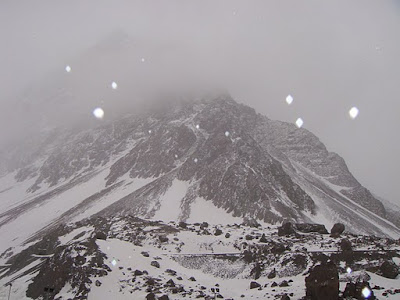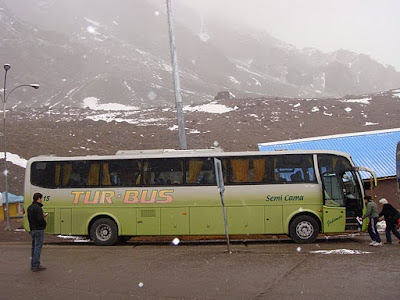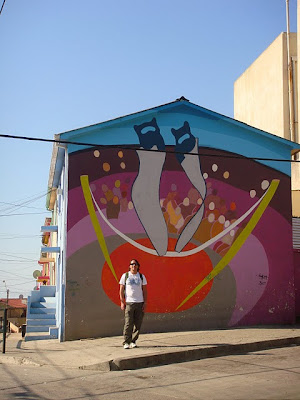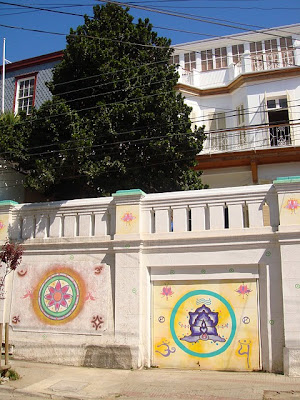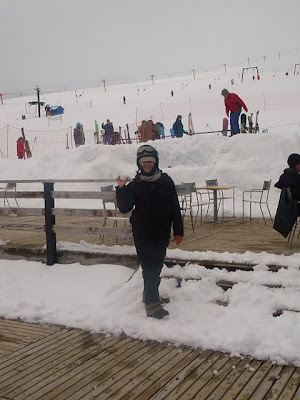Bolivia - uh, not so fun stuff
Chili was a wonderful experience. Unfortunately, Bolivia would prove to be the exact opposite. We had debated whether we should go to Bolivia at all for days and in the end I convinced Katie that it would be a good idea to see it. Turns out I was sort of wrong as I had a slight stroke of bad luck. As they say, if you travel as long as we had to this point you are bound to run in to some sort of bad luck sooner or later. It's not a matter of if but a matter of when. True statement. Actually, all things being considered we were quite lucky to have nothing at all happen to us up to this point. I mean, we had been traveling already for over 8 months with not one stroke of bad luck other than a very manageable mild health issue in Indonesia and a minor issue in Africa where they tried to extort us for money. Aside from these two small events, it had been pretty much smooth sailing up to this point. I remember sitting in some of the internet cafe's in Africa listening to person after person skype with their friends and family back home telling them horrifying stories of how they got robbed or taken advantage of in some shape or form while crying their eyes out right there in front of everyone. There were multiple of these episodes that I saw all the way through Africa. Funny thing is I was not concerned at all about our wellbeing or safety while we were in Africa. Even in Nairobi which is a very violent and scary place to be wandering around day or night. I had the best time there and was totally relaxed the whole time.
Bolivia was the only place on the entire trip that I felt concerned about our safety. Turns out my spider sense was spot on. I did some preliminary reading on what to expect while in Bolivia, the do's and don't list, and there were many cases where it became clear that this was a place that you should put your safety radar on and keep it on at all times. The reason it is such a risky place to visit is because it is such a poor country which means there are twice as many bad people lurking around street corners waiting for you to make a mistake because they have nothing to lose and everything you own to gain. Add to this the lack of any proper police force and you have a country where there is hardly any risk to being caught or punished for pillaging tourists. Makes for a perfect place for high ridden crime to occur. All that being said, we ran into multiple fellow backpackers who said that Bolivia was the most beautiful and wonderful place they visited on their entire journeys. Of course it was, it has some of the most lush forests, rivers, lakes and valleys on the planet. But the question remained, do you want to risk seeing this place where the odds of you being singled out as a target are higher than most other places on this earth? Hmmm? So after summing it all up we decided to roll the dice and go see this majestic place and hope for the best.
Since we were very near the Bolivian salt flats on the Chilean side in San Pedro de Atacama, this turned out to be our best method of entry into this curious place. So we boarded a jeep that took us on a three day ride through the salt flats. These are not just any salt flats mind you. Two things that distinguish them from any other flats in the world are 1) They are the largest than any other and 2) They are the highest ones in the world as well. The second point would prove to get the best of me. We had already been in some very high places on our journey but for whatever reason these salt flats would punish me for daring to cross them. I developed altitude sickness early on. The rules of altitude sickness are that you should descend to a lower elevation if you do get sick, acclimate a bit, and then ascend again at a slower pace. Problem was there was no place to descend to! We were on a plateau of salt 15,000 feet above sea level. Where the hell am I going to descend to? Should I dig a 5,000 foot hole in the salt? How long would that take? WTF!!! The only counter measures known in this part of the world for altitude sickness were coca leaves that were supposedly good at preventing further deterioration in symptoms. There is no scientific proof to this only local mythology. Lucky for me, cocaine is a major export for this country so coca leaves were easily accessible. In fact, our driver was chewing on them the whole way across the flats as we drove over them. I guess the phrase "when in doubt do as the locals do" should have been followed to a tee here but as fate would have it, I decided not to. For those who have experienced altitude sickness it is one of the worse things ever to go through if you are exposed to it for a long period of time. There are varying levels of it. First, you get dizzy and lightheaded, then you feel a bit dehydrated. At the next level you start to experience shortness of breath and later you feel like you are going to suffocate. At the highest level, you have all these symptoms and to make things worse you start to throw up and dry heath. This is where it gets really dangerous and some people have died because they choke themselves to death. I got to level B. Because we were stuck at this altitude for so long I started to develop shortness of breath. The worse time for me when all these symptoms were in full swing was bed time. Your body slows down and the feeling of altitude sickness is far more pronounced that when you are bouncing around doing stuff all day. I did not sleep more than 2 hours each night we were on the salt flats and it showed. I looked like and felt like a zombie! I thought I was going to suffocate every night. Such a weird and uncomfortable feeling. Needless to say I was so happy when we finally made it across those damn flats and started to descend back to civilization.
All was not lost while on the salt flats. I did get to see some of the most amazing salt flats the world has to offer. It kind of feels like you are on a distant cold planet with no signs of life on the planet. We took a lot of pictures and made some new friends along the way as well.
We finally arrived in a town called Oruro around midday after our long escapades on the salt. As if getting altitude sickness was not enough for me things took a turn for the worse. This little town had nothing to offer. It was basically a crossing point for backpackers going further into Bolivia. So we had to decide where to go from here as well as how to get there. We decided that we would go to La Paz which is the capital city of the country and the only way to get there from where we were was on a bus from hell. So we headed to the bus stand with a couple of our new friends that came across the salt flats with us and booked a couple of seats on the next available bus which was scheduled to leave at around 11:00pm. If memory serves me right it was around a 10 or 11 hr bus ride to La Paz from Oruro. We had a half day to burn so we went into town and had some food and a couple of beers to kill some time. After what seemed an eternity it was finally time to board. This is where things take a turn for the worse. As we boarded I made the grave mistake of assuming that my belongings were safe because I was on the bus and out of harms way or so I thought. Word to the wise when traveling in Bolivia: Never, ever take your eyes off your belongings or remove your belongings from your person no matter how safe you think you are. I decided to put my bag down for a few minutes so I could situate myself in my seat for the long ride. After all, everyone else around you is doing the same thing only with their bags attached to them. I placed my bag above my seat in one of those overhanging baggage storage areas so I could situate myself. It was no more than 3 minutes max, I looked up to get my bag and place it under my seat and to my amazement it was gone! Just like that! Turns out a local scumbag somehow got on the bus without a ticket and sat right behind me looking for someone to make a mistake. I was the first person to do so. He managed to take my backpack as well as another woman's bag. The woman started to scream and yell in Spanish that her bag was stolen. The husband decided to run after the guy as he darted around the corner. In all of my magnificent wisdom I decided to pursue as well. Imagine this, streets that have no lights at all, pitch dark and in a town that has no police force whatsoever. These are things you don't think of when your blood is on fire and all these irrational thoughts are going through your mind. My passport and camera and camcorder were all in my backpack! All I could think of is how I was going to pound this guy to death if I got so lucky as to catch him and get belongings back. After running around some dark, scary streets for around 20 minutes or so looking in any kind of area that might look like a hiding place I finally relented and headed back to the bus terminal. The woman's husband was talking to a security guard of some sort trying to explain what had happened in Spanish. I heard him say that he actually caught up to the thief and cornered him somewhere. The wife them asked him, well why didn't you take my purse away from him? And the man said something that made me so happy that I did not catch him. He said: Because he pulled a knife on me and said that he would kill me if I tried to take it away from him. I realized at that moment that nothing in my backpack was worth getting killed over even though this bottom dweller put me in a very bad situation. So after I recomposed myself as best I could I filled out a stolen item report with the bus company and got back on the bus and tried my best not to fall apart over what had just happened. The bus company said that they would put a reward out for the bag and that sometimes the bags get returned for the cash. I took her phone number and told her I would call her the next day to see if I might get lucky. We boarded the bus and headed to La Paz where I could only hope to get my situation rectified. As you might expect my mood the whole ride down was quite subdued but I managed to put the whole thing behind me and compose myself at least for a little while.
As I said earlier, Bolivia is a very poor country. That means there are only a few paved roads that actually go through the country. The bus ride could very well be described as 4 wheeling through the backwoods on on oversized dune buggy. Mad Max comes to mind. Seriously! Bolivia has some of the most dangerous main roads in the world. You have to remember that we are high in the Andes mountains with hardly any infrastructure in this country. In fact, there is a very famous trail called Dead Man's Road or something like that high in the mountains right outside of La Paz that some people come here just to experience on a mountain bike. Death defying sharp and narrow turns that have a 200 to 300 foot drop if you miss them? Uh, no thanks I'll pass. Must sound like a rush to some people but try doing a road like this on an 11 hour bus ride that is oversized and overloaded! That is exactly what we did in the wee hours of the morning. Crazy stuff!
La Paz was a very interesting city. It is nestled high in the Andes mountain range. The interesting thing is that it is situated in a huge crevasse between two mountain peaks and parts of the town actually ascend up the sides of the mountains to the top. One of the only places in the world where if you live on the hillside you have to descend a few thousand feet if you want to pick up a loaf of bread downtown or just meet a few friends in the city for a cup of Jo. La Paz is the highest capital city in the world. It's lowest elevation is just over 10,000 feet above sea level. The highest elevation is just over 13, 300 feet above sea level. The geography of La Paz in particular the altitude is not only unique but also reflects their society as well. The lower areas of the city are the most affluent parts of the city. Most middle-class residents live in the middle elevations near the city center. Lastly, the very lower class people all live in the projects type of communities that are spread out all along the very high elevations. Very interesting place to see in real life for sure. The people are even more interesting. You see a bunch of chubby little women walking around with little round hats and rainbow-like dresses buying veggies along the street markets or running errands. The main area in the city is called "El Prado" . This place is lined with all kinds of restaurants, clubs, stores, street markets, etc. all pretty much centralized for efficiency purposes. We hung out in this area during most of our stay. We visited one museum just out of sheer curiosity. Give you one guess which one it was. That's correct, we went to the Coca museum to learn the history of the coca industry and how it got to where it is today. It was $2 very well spent and I got some free coca leaves to chew on my way out. The rest of the time was spent roaming the various market streets and eating some food Bolivian-style. We were fortunate to be there during a national parade day. I forgot what it was. Maybe Katie will remember when she writes her account out. We got a good glimpse of Bolivian culture and style on parade day.
As luck would have it there is a U.S. Embassy right smack in the middle of La Paz. This was a very fortunate break for me since I was in need of a new passport now and would not be able to exit the country without one. So I made an appointment as quickly as possibly. I will just spare you all the details which are very interesting by the way and tell you that after a fair amount of red tape I was able to get a temporary replacement for my stolen passport. I can't emphasize to you enough just how lucky I was to have been headed to La Paz after getting my backpack lifted on that bus. I heard stories from other people traveling with us who said they knew people that had gotten their passports stolen and had to travel for days just to get to a town where there was an embassy for them and how some of them were trapped for months because it took that long to get a new one. All things being considered, I was very fortunate to be in the right place at the right time for something as unfortunate as my passport being stolen in a very unstable and quite frankly scary country. I am very grateful to the gods that they were watching over me during this whole ordeal. The only downer to getting my passport renewed was that the Bolivian government decided that the only way I would get it back was to leave the country immediately when by international law I really had 30 days to stay if I so chose to. This as I soon learned(as I was given a 30 minute lecture from the US representative at the embassy who herself was of Bolivian decent) was due to some bad blood between the U.S. Embassy and Bolivian government that had been brewing for some time.
No worries, the positives out of all of this was that I could continue my journeys relatively uninterrupted as opposed to the alternative worse case scenario of being stuck in a scary place for an uncertain amount of time or worse being forced to go home and that I learned "firsthand" about how an undeveloped country like Bolivia with no real legal system to speak of and a complete lack of property rights operates in comparison to the developed world. Very interesting stuff, indeed.
The only other thing we wanted to do while in Bolivia was to visit the very fabled and historic Lake Titikaka which is the birthplace of the Inca Gods and one of the most sacred places on earth. But we never got this opportunity because they kicked us out of the country. Not to worry. Again because luck was on our side in all this unfortunate experience we were still able to see Lake Titikaka because it happens to be a part of the dividing line between Bolivia and Peru. In fact, the line cuts the lake right smack in the middle. So instead of seeing the Bolivian side of the sacred lake we would just visit the Peruvian side instead. So in the end it all worked out. Truth be told we could have taken a boat from Peru to the other side of the lake and seen it all and gone unnoticed. But we decided to take the safe side and not take any unnecessary risks. Just being able to take a boat ride on the holy lake and be a part of the lake passages that the ancient Inca's made was all I needed.



































